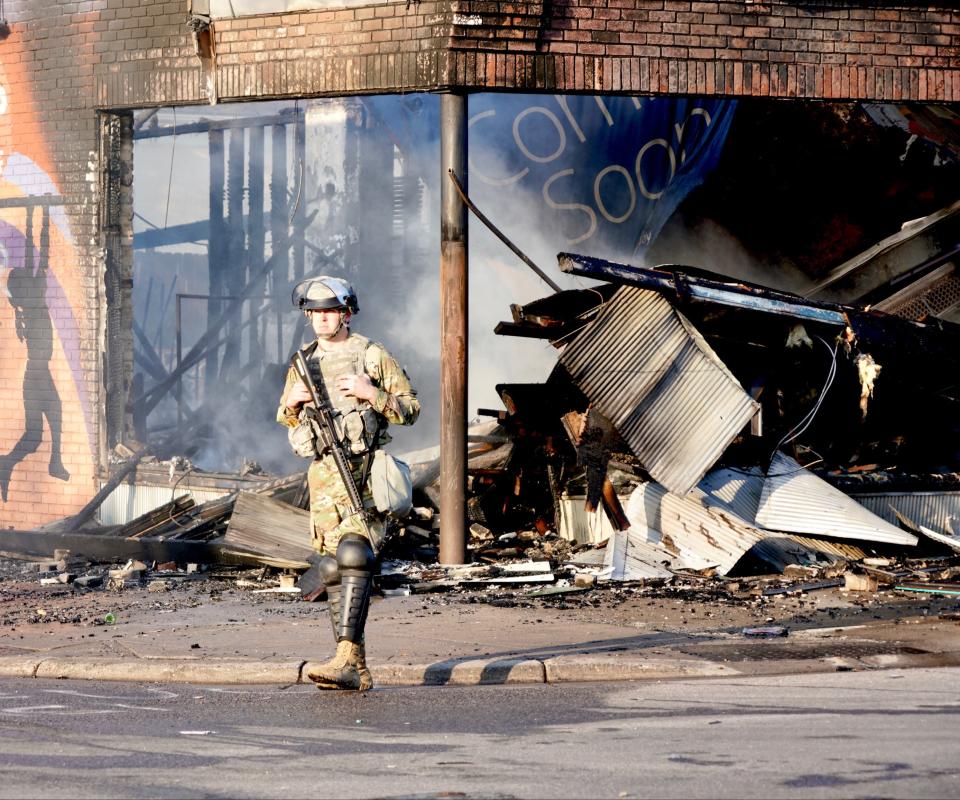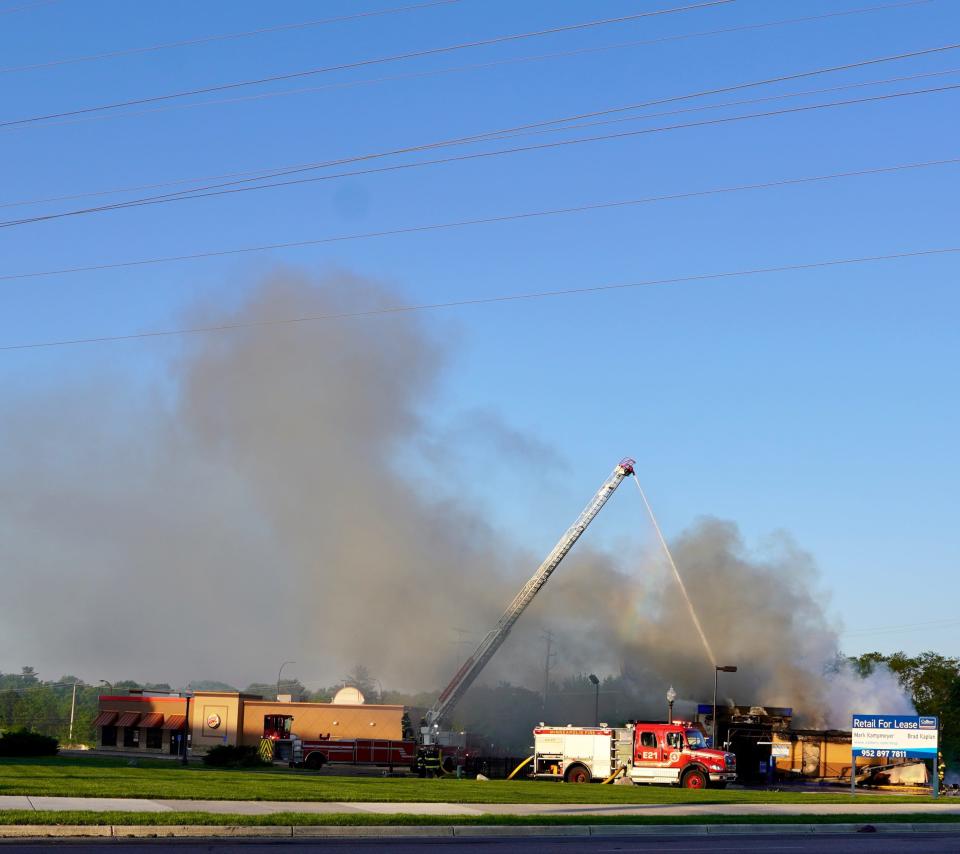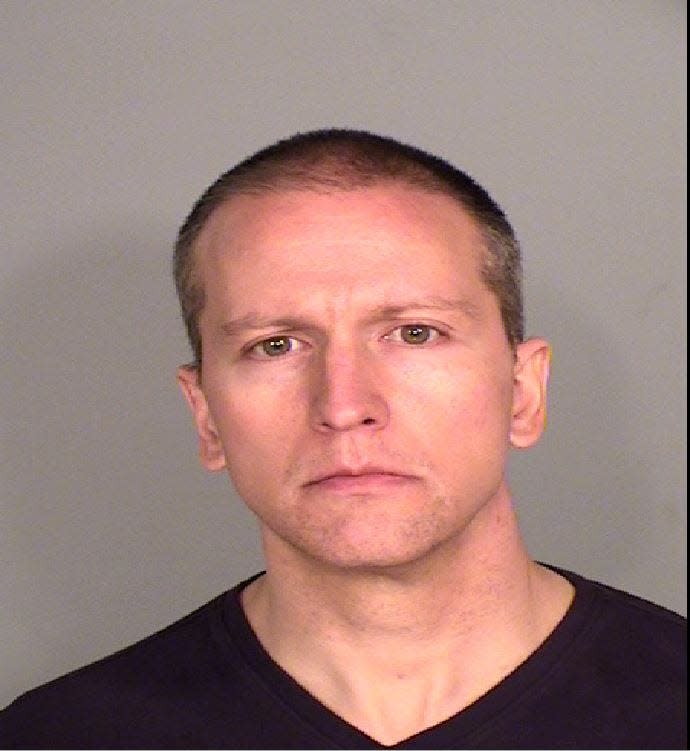George Floyd protests in Minneapolis: Police use tear gas, smoke grenades; more than two dozen arrested
MINNEAPOLIS — Police used tear gas, smoke grenades and nonlethal projectiles Saturday night in a coordinated effort to beak up groups gathering after the start of the Twin Cities' curfew, aimed at preventing another night of violent protests after days of unrest following the death of George Floyd.
Several hours after the 8 p.m. curfew began, there were "no reported injuries of consequence," Minnesota Department of Corrections Commissioner Paul Schnell told the media. He acknowledged that the situation could change as the night continued.
Minneapolis mayor Jacob Frey reported at least two dozen arrests were made Saturday night and said it was too early to say whether the curfew would be extended another night.
Earlier Frey said even peaceful protests weren't welcome after the curfew. Highways were closed and officials urged all residents to stay home, saying it was necessary to separate peaceful protesters from those intending to cause further damage to a city reeling after days of fiery demonstrations.
“Don’t go out of your homes; don’t make things more difficult,” Minnesota governor Tim Walz said. Local officials' increasingly strict stance comes after days of violence in the city, with Thursday night's unrest being the most chaotic as protesters breached a police precinct building and set it on fire.
Floyd, a 46-year-old black man, died Monday after a white Minneapolis police officer kept his knee pressed into his neck for more than eight minutes, sparking dozens of protests against police brutality across the country.
City-by-city look: George Floyd protests continue Saturday, cities begin issuing curfews
Thousands of people took to the streets nationwide and hundreds were arrested Friday and into early Saturday morning, resulting in injuries to protesters and officers. By sunrise, at least three people had died amid the protests.
Demonstrations continued throughout the day Saturday in dozens of cities, and more protests were planned and curfews issued for Saturday evening.
Follow USA TODAY reporters Trevor Hughes and Tyler Davis for reports from the scene. Our live blog will be updated throughout the day. Here are the latest developments:
Minnesota Department of Transportation announced multiple highway closures in the Twin Cities, starting at 7 p.m. Saturday. "Routes will remain open for motorists to exit downtown areas," the department tweeted.
Officials expected demonstrators to set fires, use deadly force and use "civilians as shields from law enforcement," the Minnesota Department of Public Safety tweeted before and after curfew began.
As part of the state's increased enforcement, the Minnesota National Guard said more than 4,100 service members had been deployed to the Twin Cities and projected more than 10,000 would soon be called up.
Who is causing the violence? Extremists are hijacking peaceful protests, officials say
Read this: Experts say knee-to-neck restraint is dangerous, but Minneapolis allows it.
Tear gas, smoke bombs and explosions near Fifth Precinct
Hundreds of protesters sat to await the arrival of law enforcement as curfew approached near Fifth Precinct. One commented that police couldn't arrest the whole group.
Soon, black-clad law enforcement approached to the sound of explosions. Some demonstrators chanted “Hands up, don’t shoot!”
Police officers fired nonlethal projectiles toward masses of people, including a crowd of media gathered in an alley next to a looted store.
Protesters reported tear gas being used. Some people hobbled away from an intersection appearing to be injured.
"State Patrol troopers are moving in to secure the Fifth Precinct. Go home and obey the curfew order now," Minnesota Department of Public Safety tweeted.
An empty street fills as curfew falls near Lake Street
Minneapolis' Lake Street was the scene of running battles between protesters, law-enforcement and the Minnesota National Guard on Friday night. But as curfew began Saturday, it was nearly empty and eerily quiet.
Smoke still wafted from some of the burned-out buildings, including the Third Precinct police substation. Earlier in the day, hundreds of volunteers swept clean the debris that once clogged the streets.
Soon, the area was filled with people again as a crowd materialized.
A group headed across the Mississippi River bridge on Lake Street from Minneapolis toward Saint Paul, initially with no sign of law enforcement.
Moments later, police pushed back the large protest group. Under a heavy barrage of flash-bangs and smoke grenades, the group quickly retreated, chanting “We come in peace, we mean no harm.”
Officials walk back claims about out-of-state arrests
Walz and Carter alleged early Saturday that many of the protesters inciting violence and causing destruction were from outside the state but later acknowledged current data does not support that claim.
A civil arrest list provided by the public information officer of the St. Paul Police Department shows 12 of the 18 people arrested from Thursday through 6 a.m. Saturday were from Minnesota. Five of them are from St. Paul, three are from Woodbury (part of the Twin Cities metropolitan area), two are from Minneapolis, one is from Mankato and one is from St. Louis Park. Four are from out of state and two did not have cities of residence listed.
Carter said his statements were based on data he later learned was inaccurate. Walz said arrests made Saturday night will give officials a “much bigger data set” of where protestors are from.
As grocery stores close in Minneapolis, volunteers offer help
Volunteers on the north side of Minneapolis on Saturday afternoon turned parking lots into makeshift markets to combat a dearth of grocery stores in the area.
At the intersection of West Broadway and Emerson avenues, about 250 people filled the lots at U.S. Bank and Episcopal Church in Minnesota to drop off and pick up donations from members of the community.
Amanda Kelli, 18, has relatives who live on the north side and said it’s been a struggle to find food the past few days.
“My family has been looking for somewhere to go grocery shopping — my mom, my dad my grandma,” she said, as she held her baby and chowed on pizza. “But we couldn’t find nothing so we came here.”
All businesses along Broadway appeared to be closed as of Saturday afternoon due to violent protests the past two nights.
Breyonne Golding, a community planner, called the donation effort “healing” for a low-income area usually starved of resources, but even more so now.
“On the north side, there’s only three grocery stores. All of them are boarded up,” said Golding, a native of Connecticut. “It’s about to be the first of the month, where are they gonna get food?”
Omar to Minneapolis residents: ‘Stay home tonight’
Rep. Ilhan Omar asked Minneapolis residents to stay home Saturday night in an effort to isolate "agitators" she says are destroying minority owned business during protests over the death of Floyd.
Omar, D-Minn., represents the district where Floyd was killed.
"Right now, our grief and pain is being exploited. People primarily from outside our city are destroying black and minority-owned businesses in our city,” Omar said. “We can’t let them. Let us all prioritize justice for George Floyd, police reform, alongside the safety of our community and the prevention of more violence. I urge people to stay home tonight so we can better target and isolate these agitators.”
– Sean Rossman
Minnesota National Guard plans to deploy as many as 10,000 soldiers
The Minnesota National Guard planned to deploy as many as 10,000 troops to respond to unrest in Minneapolis, a massive increase over the 850 now on duty.
Meanwhile, the Pentagon offered to assist Minnesota with active-duty troops. So far, Walz has not sought help from federal troops, according to a statement from Jonathan Hoffman, a Defense Department spokesman.
Walz said this morning that he had spoken with the Secretary of Defense and the Chairman of the Joint Chiefs on Saturday, as well as with mayors across the country, and was "fully mobilizing" the state's National Guard for the first time in Minnesota's history.
Walz alleged that the protests were fueled by elements of domestic terrorism, ideological extremists and international destabilization.

'Stay home tonight,' officials and community leaders plead
In an afternoon news conference, Minnesota officials asked residents to forgo protests and stay home after 8 p.m. Saturday night so that law enforcement could "remove those folks who are harming us." Community and faith leaders – including reverends, rabbis, imams and representatives of the state's Latino, Asian, and Native American communities, as well as the uncle of Philando Castile – encouraged residents to observe the curfew.
"We need to create the space for people to be able to grieve, to come together, to mourn the loss of George Floyd," Lt. Gov. Peggy Flanagan said in an afternoon news conference. "We cannot do that until community can gather safely ... Stay home tonight so that we can remove those folks who are harming us."
Flanagan said that some of the protesters were "detractors," "white supremacists" and "anarchists."
"They are not from our state, and they're coming from the outside," and Sen. Amy Klobuchar. "We cannot move forward when people are burning down our city."
Volunteers begin cleaning up
Across Minneapolis, groups of volunteers spontaneously appeared to begin cleaning up the damage Saturday morning.
Leaning on her shovel while talking, social worker Kara Vangen, 58, said no one should mistake the cleanup as a criticism of the protests themselves.
"I’m supporting the protesting, completely. And this is my neighborhood, so this is part of the healing," she said, over the scrape of shovels clearing rubble from a burned-out Walgreens.
Wearing face masks, Anton Reuter and Beno Boda, both 17, picked up trash strewn in the street.
The two, who live nearby, said they had heard reports that troublemakers from outside downtown Minneapolis have been flooding into the area last night causing damage. They wanted people to know that those who live here care about this neighborhood.
"It’s not going to get better waiting on the government," Boda said.
Morning in Minneapolis: Firefighters put out blazes, clear rubble
As Saturday morning dawned in Minneapolis, authorities had moved back into some formerly contested areas, and firefighters with the Minneapolis Fire Department poured water onto a still-smoldering gas station in the Hiawatha area as a small crowd watched. No police were present.

Over on Lake Street at Columbus Avenue, members of the Minnesota National Guard controlled access to the streets, their Humvees and trucks blocking the road as firefighters and public works officials tried to shut off leaking gas lines and clear rubble from the road.
Because some areas lost power, drivers collided yesterday when speeding through stoplights that weren’t working, and their abandoned crashed cars were then set ablaze. Broken glass from shattered windows and bus stops crunched underfoot.
"This is sad. It’s very emotional right now. I just had to come down and see it," said Brian Ledin, 58, who lives in a nearby suburb but was born in the area.
Smoke rose from an O’Reilly Auto Parts store and CenterPoint energy workers searched for broken gas lines.
Report: Military police could be dispatched to Minnesota
The Pentagon on Saturday ordered the Army to put military police units on alert to head to Minneapolis on short notice at President Donald Trump’s request, the Associated Press reports, according to three people with direct knowledge of the orders who did not want their names used because they were not authorized to discuss the preparations.
According to the AP report, soldiers from Fort Bragg in North Carolina and Fort Drum in New York have been ordered to be ready to deploy within four hours if called. Soldiers in Fort Carson in Colorado and Fort Riley in Kansas have been told to be ready within 24 hours.
Fired Minneapolis police officer Derek Chauvin arrested, booked
Derek Michael Chauvin, 44, was arrested Friday and charged with third-degree murder and manslaughter in connection to Floyd's death. He was booked into the Ramsey County Jail.
A criminal complaint that references body cameras worn by the four now-former officers involved in the incident sheds additional light on what happened on Memorial Day in the moments before and after Floyd's death.

The Hennepin County Attorney's complaint said Chauvin had his knee on Floyd’s neck for 8 minutes and 46 seconds, including two minutes and 53 seconds after Floyd was non-responsive. Read more.
This article originally appeared on USA TODAY: George Floyd protests: Minneapolis police use tear gas; dozens arrested

